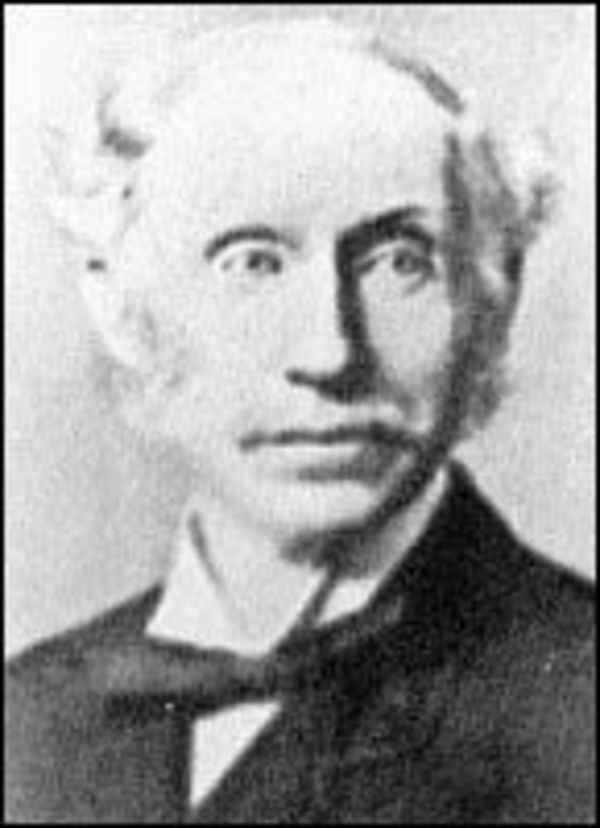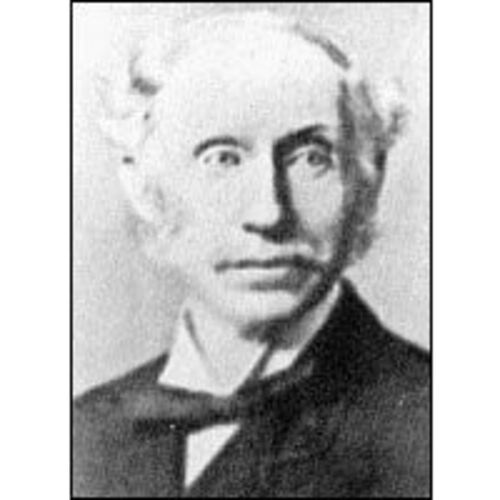
Source: Courtesy of Wikimedia Commons
THORBURN, Sir ROBERT, merchant and politician; b. 28 March 1836 at Juniper Bank, near Walkerburn, Scotland, son of Robert Thorburn and Alison Grieve; m. 1865 Susanna Janetta Milroy of Hamilton, Upper Canada, and they had five children; d. 12 April 1906 in St John’s.
The Thorburns were part of a network of Scottish families from the Glasgow-Greenock area involved in the Newfoundland trade from the late 18th century. After an education in Edinburgh, Robert Thorburn was dispatched to St John’s in 1852 to work for Baine, Johnston and Company, then owned by his uncles Walter* and James Johnston Grieve. In 1855 the former established his own business as Walter Grieve and Company, trading at Greenock and St John’s, and seven years later Thorburn became his Newfoundland agent and partner.
He first became politically active in the late 1860s, when he took part in the campaign against confederation, no doubt at the behest of Grieve. Probably as a reward, Thorburn in 1870 was appointed to the Legislative Council by the anti-confederate government of Charles James Fox Bennett*. He was prominent in the St John’s Chamber of Commerce, the General Water Company, and other local businesses, and was a director of the Union Bank of Newfoundland. He was asked to run for St John’s districts in the 1878 and 1882 elections but refused.
His views were those of a moderate mercantile conservative. He doubted the wisdom of building a transinsular railway and a large dry dock in St John’s, and resented the growing anti-mercantile propaganda emanating from the government, led by Sir William Vallance Whiteway. Like others of his class, he viewed with dismay the expansion of the French fishery on the Grand Banks in the 1880s, and thought that it should be curbed by restrictions on the export of bait fish to foreign fishermen. Such attitudes placed him firmly in the New party opposition to Whiteway’s policies.
In 1885 a political crisis developed following an Orange-Catholic riot at Harbour Grace [see Whiteway; Robert John Kent*]. The Catholic Liberals deserted Whiteway, and a movement developed to form a united Protestant party under James Spearman Winter*. Such an amalgamation took place in October, but only because Whiteway agreed to retire from politics and Winter to abandon his claims to lead the new party. The compromise leader was Thorburn. He took over as premier on 12 Oct. 1885. His Reform party ran a virulently sectarian campaign in the subsequent election, pledging “no amalgamation with the Roman Catholics” and beating the Orange drum. Behind that smoke-screen lay a mercantile agenda stressing financial caution, attention to the fisheries, and an attack on the French bank fishery through bait controls. The election results largely followed sectarian lines, the Reform party winning a four-seat majority. Thorburn was elected in Trinity.
Despite the slogans, Thorburn and other Reformers wished to come to an agreement with the Catholic Liberals, led by Sir Ambrose Shea. However, the government’s opposition to Shea’s being appointed governor caused great offence among Catholics, and Thorburn had to construct an exclusively Protestant cabinet. Encouraged by Governor Sir George William Des Vœux, he reopened negotiations in the spring of 1886. The result was an agreement whereby most Liberal members crossed the house to join the Reform party, and Catholics received two cabinet posts [see Maurice Fenelon*]. The price demanded by the Liberals, however, had important implications for government policy.
In the winter 1886 session the government had resisted pressure from other parties to resume work on the railway, halted in 1884; had stressed the need for financial caution and for rural development schemes; and had passed a bait bill, to which the imperial government was reluctant to assent. The Liberals accepted bait legislation, but demanded other changes. Their price was the construction of a branch railway to Placentia, the centre of a Catholic district, and money for a sewer system in St John’s. The loosening of the purse-strings was further encouraged by a severe economic depression. After poor fisheries in 1886, the government instituted an elaborate program of public works. Similar expenditures during the rest of its term were paid for in part by the colony’s first foreign loans.
In London to attend the first Colonial Conference in 1887, Thorburn, with assistance from Shea and Des Vœux, obtained imperial assent to the bait bill. It had far less impact on the fishery than had been anticipated, but the French were offended, and a period of acute difficulties concerning the French Shore began. The Bait Act was also of concern to the Canadian government, which was in addition worried by Newfoundland’s decision to seek an independent reciprocity treaty with the United States. As a result, thoughts turned again to confederation. At the prompting of Alfred Bishop Morine*, a Nova Scotian-born journalist who had entered the Newfoundland House of Assembly in 1886, Sir Charles Tupper* visited St John’s in 1887, and at the meeting of the fisheries commission in Washington broached the subject with Winter. The latter’s attempt to persuade the government to send a delegation to Canada nearly brought it down. Thorburn favoured talks, but remained fearful of confederation’s impact on the Newfoundland economy. His government was badly divided on the issue, faced widespread opposition, and in the end could only agree to send a delegation with no powers to negotiate. Not surprisingly the Canadian government turned the offer down.
As the 1889 election approached, it became clear that the Reform party had failed to implement a credible alternative policy to that offered by Whiteway and the pro-railway forces, or, despite a useful legislative record, to impress the electorate. Challenged by a new Liberal party led by Whiteway, the Reformers hastily revived work on the railway and produced a list of promises designed to beat the opposition at its own game, but the government was trounced. Every cabinet minister was defeated, and in Trinity Thorburn came at the bottom of the poll. The blame for this débâcle should rest with the professional politicians in the Reform party, especially Winter, rather than with Thorburn, who was inexperienced and not a natural leader.
He remained the titular leader of what became known as the Tory party for some years, but as the 1893 election approached it was intimated that his services were no longer required. Unhappy at this rejection and offered blandishments by the Liberals, he ran for that party in Bonavista. He lost, but Whiteway appointed him to the Legislative Council in 1894.
Sir Robert – as he had been since 1887 – was deeply immersed in his business. Grieve had died in 1887, and it fell to Thorburn to sort out the firm’s affairs. He sold the premises at Trinity, placed the sealing steamers in a limited liability company, and took the rest with him into a new partnership with James C. Tessier. Formed in 1888, Thorburn and Tessier was for a short time one of the largest of the St John’s fish exporters. However, though the merger was financed in part by Tessier, Thorburn had had to turn to the Union Bank, of which he was now chairman: Walter Grieve and Company had no capital left. Difficult trading conditions made it impossible for the firm to eliminate its debt, which by 1894 stood at $473,000. On 10 December the two Newfoundland banks closed their doors [see James Goodfellow*]; Thorburn and Tessier was among many local firms to suspend business.
The firm held assets of $385,000. Offers of 50 and 60 cents on the dollar were refused, and the business was wound up in 1897. Thorburn claimed that it was solvent, and that he had been forced out by hostile trustees. The Liberal press suggested that the liquidation was Tory punishment for having changed sides, and since some other firms in no better condition survived the crash, there may be truth to such accusations.
It is less likely that Thorburn was singled out because he was a bank chairman facing prosecution. Criminal charges had in fact been laid against him as a result of the closure of the Union Bank, obliging him to resign from the Legislative Council. The case was eventually dropped late in 1897, and Thorburn resumed business on a reduced scale. He took to writing verses for the local press. In 1900 the Liberals appointed him to the fisheries board. He refused an invitation to run in a 1902 by-election and died four years later at the age of 70. Obituaries spoke of his good sense, kind disposition, and conciliatory manner. Governor Sir William MacGregor called him “a man of high character, and greatly respected in this community.” Similar sentiments had been expressed by governors Des Vœux and Sir John Terence Nicholls O’brien. Prominence had been thrust upon Thorburn, and it cannot be claimed that he was a successful political leader. He was, rather, a decent man with a strong sense of public duty who as a result found himself used by others.
Some examples of the poetry which Sir Robert Thorburn published in his latter years are “The hoisting of the banners” and “Dedicated to Samuel Mucklebacket, esq.,” Nfld Quarterly, 4 (1904–5), no.2: 8, and no.3: 19, and memorial tributes to the American temperance leader Frances Elizabeth Caroline Willard in the Daily News (St John’s), 9 April 1898, and the Newfoundland poet Isabella Whiteford Rogerson in the Methodist Monthly Greeting (St John’s), March 1905.
Maritime Hist. Arch., Memorial Univ. of Nfld (St John’s), Keith Matthews coil., esp. ser.i, Thorburn name file. Newfoundland Hist. Soc. (St John’s), Sir Robert Thorburn file. PRO, CO 194/211: 7, 9; 194/213: 245–46; 194/230: 207; 194/263: 15. Daily News, 11 Nov. 1902, 14 April 1906. Evening Herald (St John’s), 10 Nov. 1893, 28 Sept. 1897, 21 March 1900. Evening Mercury (St John’s), 14 April 1888, 12 Nov. 1889. Evening Telegram (St John’s), 28 Sept. 1882; 5 Oct. 1887; 19 Sept. 1888; 16 Jan. 1895; 1, 6, 20 Oct. 1897; 23 Aug. 1902. Morning Chronicle (St John’s), 5 Feb. 1868, 12 Oct. 1878. Newfoundlander, 23 Feb. 1865, 23 Feb. 1877, 8 Oct. 1878. Public Ledger, 17 April 1880; 2 April, 17 May 1881; 7 March, 19, 26 May, 3 June 1882. Times and General Commercial Gazette (St John’s), 15 Feb. 1865. Melvin Baker, “The government of St. John’s, Newfoundland, 1800–1921” (phd thesis, Univ. of Western Ont., London, 1981), 229. The crown vs. the directors of the Union Bank of Newfoundland; evidence and exhibits, taken and produced at the preliminary investigation before His Honour Judge Conroy . . . ([St John’s, 1895]), 105. G. W. Des Vœux, My colonial service in British Guiana, St. Lucia, Trinidad, Fiji, Australia, Newfoundland, and Hong Kong, with interludes (2v., London, 1903), 2: 166. Hiller, “Hist. of Nfld,” 116–66, 185–89, 323–26. Harvey Mitchell, “Canada’s negotiations with Newfoundland, 1887–1895,” Historical essays on the Atlantic provinces, ed. G. A. Rawlyk (Toronto, 1967), 242–59. Prowse, Hist. of Nfld (1896), 514.
Cite This Article
J. K. Hiller, “THORBURN, Sir ROBERT,” in Dictionary of Canadian Biography, vol. 13, University of Toronto/Université Laval, 2003–, accessed April 23, 2025, https://www.biographi.ca/en/bio/thorburn_robert_13E.html.
The citation above shows the format for footnotes and endnotes according to the Chicago manual of style (16th edition). Information to be used in other citation formats:
| Permalink: | https://www.biographi.ca/en/bio/thorburn_robert_13E.html |
| Author of Article: | J. K. Hiller |
| Title of Article: | THORBURN, Sir ROBERT |
| Publication Name: | Dictionary of Canadian Biography, vol. 13 |
| Publisher: | University of Toronto/Université Laval |
| Year of revision: | 1994 |
| Access Date: | April 23, 2025 |



